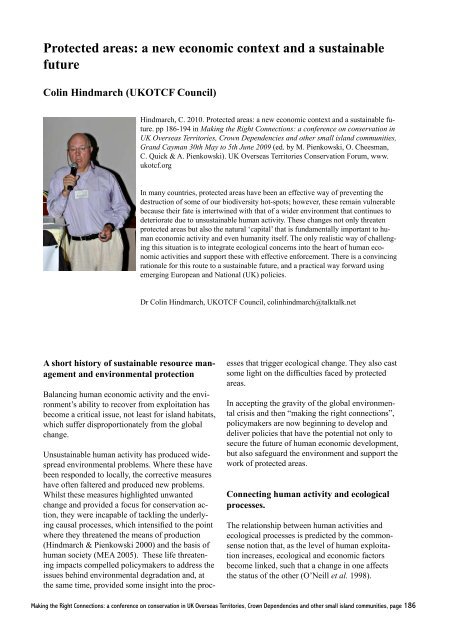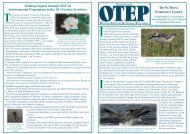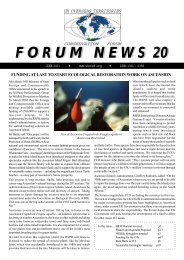Section 06 - UKOTCF
Section 06 - UKOTCF
Section 06 - UKOTCF
You also want an ePaper? Increase the reach of your titles
YUMPU automatically turns print PDFs into web optimized ePapers that Google loves.
Protected areas: a new economic context and a sustainable<br />
future<br />
Colin Hindmarch (<strong>UKOTCF</strong> Council)<br />
Hindmarch, C. 2010. Protected areas: a new economic context and a sustainable future.<br />
pp 186-194 in Making the Right Connections: a conference on conservation in<br />
UK Overseas Territories, Crown Dependencies and other small island communities,<br />
Grand Cayman 30th May to 5th June 2009 (ed. by M. Pienkowski, O. Cheesman,<br />
C. Quick & A. Pienkowski). UK Overseas Territories Conservation Forum, www.<br />
ukotcf.org<br />
In many countries, protected areas have been an effective way of preventing the<br />
destruction of some of our biodiversity hot-spots; however, these remain vulnerable<br />
because their fate is intertwined with that of a wider environment that continues to<br />
deteriorate due to unsustainable human activity. These changes not only threaten<br />
protected areas but also the natural ‘capital’ that is fundamentally important to human<br />
economic activity and even humanity itself. The only realistic way of challenging<br />
this situation is to integrate ecological concerns into the heart of human economic<br />
activities and support these with effective enforcement. There is a convincing<br />
rationale for this route to a sustainable future, and a practical way forward using<br />
emerging European and National (UK) policies.<br />
Dr Colin Hindmarch, <strong>UKOTCF</strong> Council, colinhindmarch@talktalk.net<br />
A short history of sustainable resource management<br />
and environmental protection<br />
Balancing human economic activity and the environment’s<br />
ability to recover from exploitation has<br />
become a critical issue, not least for island habitats,<br />
which suffer disproportionately from the global<br />
change.<br />
Unsustainable human activity has produced widespread<br />
environmental problems. Where these have<br />
been responded to locally, the corrective measures<br />
have often faltered and produced new problems.<br />
Whilst these measures highlighted unwanted<br />
change and provided a focus for conservation action,<br />
they were incapable of tackling the underlying<br />
causal processes, which intensified to the point<br />
where they threatened the means of production<br />
(Hindmarch & Pienkowski 2000) and the basis of<br />
human society (MEA 2005). These life threatening<br />
impacts compelled policymakers to address the<br />
issues behind environmental degradation and, at<br />
the same time, provided some insight into the processes<br />
that trigger ecological change. They also cast<br />
some light on the difficulties faced by protected<br />
areas.<br />
In accepting the gravity of the global environmental<br />
crisis and then “making the right connections”,<br />
policymakers are now beginning to develop and<br />
deliver policies that have the potential not only to<br />
secure the future of human economic development,<br />
but also safeguard the environment and support the<br />
work of protected areas.<br />
Connecting human activity and ecological<br />
processes.<br />
The relationship between human activities and<br />
ecological processes is predicted by the commonsense<br />
notion that, as the level of human exploitation<br />
increases, ecological and economic factors<br />
become linked, such that a change in one affects<br />
the status of the other (O’Neill et al. 1998).<br />
Making the Right Connections: a conference on conservation in UK Overseas Territories, Crown Dependencies and other small island communities, page 186







